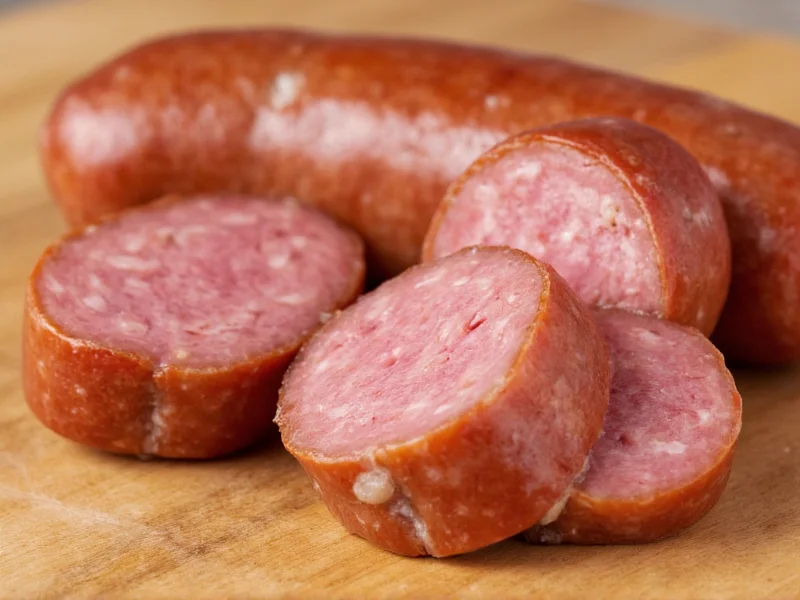When cooking pork sausage, precise temperature control isn't just about quality—it's a critical food safety requirement. Undercooked sausage poses serious health risks, while overcooked sausage becomes dry and crumbly. This guide provides authoritative information on achieving perfect pork sausage every time, based on current food safety standards from the United States Department of Agriculture (USDA).
Why 160°F Is the Critical Temperature for Pork Sausage
The 160°F (71°C) threshold represents the minimum internal temperature required to eliminate dangerous pathogens commonly found in raw pork. At this temperature, harmful bacteria including Salmonella, E. coli, and Trichinella spiralis are completely destroyed within seconds. Unlike whole muscle cuts like pork chops (which can be safely cooked to 145°F), ground pork products like sausage require higher temperatures because the grinding process distributes surface bacteria throughout the meat.
| Meat Product | Safe Internal Temperature | Rest Time |
|---|---|---|
| Ground pork (sausage) | 160°F (71°C) | No rest required |
| Pork chops/roasts | 145°F (63°C) | 3 minutes |
| Pre-cooked sausage | 140°F (60°C) | No rest required |
Proper Technique for Measuring Sausage Temperature
Accurate temperature measurement requires both the right equipment and proper technique:
- Digital instant-read thermometers provide the most reliable results for sausage (avoid dial thermometers which are less precise)
- Insert the probe into the thickest part of the sausage, avoiding contact with the cooking surface
- For patties, insert horizontally from the side to reach the center
- Check multiple sausages in a batch as temperatures can vary
- Sanitize the thermometer probe between readings
Many home cooks make the mistake of relying on visual cues alone. While properly cooked pork sausage will appear brown throughout with clear juices, these indicators aren't reliable for determining food safety. The only accurate method for checking pork sausage internal temperature is using a calibrated food thermometer.
Differentiating Between Sausage Types
Understanding sausage varieties prevents cooking errors:
Fresh Pork Sausage
Raw sausage made from ground pork, seasonings, and sometimes breadcrumbs. Must reach 160°F for safety. Common forms include breakfast links, Italian sausage, and bratwurst (though traditional bratwurst contains pork and veal).
Pre-Cooked Sausage Products
These include hot dogs, kielbasa, and other smoked sausages that have already been cooked during processing. While safe to eat cold, heating these products to 140°F enhances flavor and texture. Do not confuse these with fresh sausage requiring 160°F.
Common Temperature Mistakes and How to Avoid Them
Even experienced cooks make these critical errors when checking pork sausage temperature:
- Testing too early - Checking temperature before the sausage has had time to cook through gives false low readings
- Single-point testing - Measuring only one sausage in a batch ignores temperature variations
- Surface contact - Letting the probe touch the pan or grill creates artificially high readings
- Insufficient calibration - Using uncalibrated thermometers can result in 5-10°F inaccuracies
For best results, calibrate your thermometer monthly using the ice water (32°F) or boiling water (212°F) method. Digital thermometers typically require less frequent calibration than analog models.
Food Safety Risks of Improperly Cooked Sausage
Serving sausage below 160°F risks serious foodborne illness. Trichinella parasites, though rare in commercially raised pork, can cause trichinosis with symptoms including abdominal pain, diarrhea, fever, and muscle pain. More commonly, Salmonella and Staphylococcus aureus contamination can cause severe gastrointestinal distress.
The USDA reports that ground meat products are among the most common sources of foodborne illness because the grinding process distributes surface contaminants throughout the product. This makes proper temperature monitoring especially critical for sausage compared to whole muscle cuts.
Storage Guidelines for Cooked Sausage
After reaching the proper internal temperature, handle cooked sausage safely:
- Refrigerate within 2 hours of cooking (1 hour if ambient temperature exceeds 90°F)
- Store in airtight containers for up to 3-4 days
- Reheat to 165°F before serving leftovers
- Freeze for longer storage (up to 2-3 months for best quality)
Perfect Sausage Cooking Tips
Beyond temperature, these techniques ensure delicious results:
- Cook over medium heat to prevent exterior burning before interior reaches 160°F
- Avoid piercing sausage skins, which releases flavorful juices
- For even cooking, bring sausage to room temperature before cooking
- When grilling, use a two-zone fire to move sausages away from direct heat if browning too quickly
Frequently Asked Questions
Can pork sausage be slightly pink at 160°F and still be safe?
Yes, properly cooked pork sausage may retain a slight pink hue even when it reaches the safe internal temperature of 160°F. This occurs due to myoglobin retention and is not an indicator of undercooking. Always verify with a thermometer rather than relying on color alone.
How long should pork sausage rest after reaching 160°F?
Unlike larger cuts of meat, ground pork products like sausage don't require resting time. You can serve immediately after reaching 160°F since the fine texture allows heat to distribute evenly without significant carryover cooking.
What's the difference between pork sausage and chicken sausage temperature requirements?
Pork sausage requires 160°F while chicken or turkey sausage must reach 165°F. This higher temperature for poultry products accounts for different pathogen risks, particularly Salmonella which is more prevalent in poultry.
Can I use a meat thermometer for frozen sausage?
Yes, but you must insert the thermometer deep enough to reach the sausage's core. Frozen sausage requires longer cooking time to reach 160°F internally. Never partially thaw sausage at room temperature, as this creates ideal conditions for bacterial growth in the outer layers.
Does sausage temperature differ when using different cooking methods?
The safe internal temperature remains 160°F regardless of cooking method (grilling, pan-frying, baking, or boiling). However, cooking times vary significantly between methods. Always verify with a thermometer rather than relying on time estimates alone.











 浙公网安备
33010002000092号
浙公网安备
33010002000092号 浙B2-20120091-4
浙B2-20120091-4